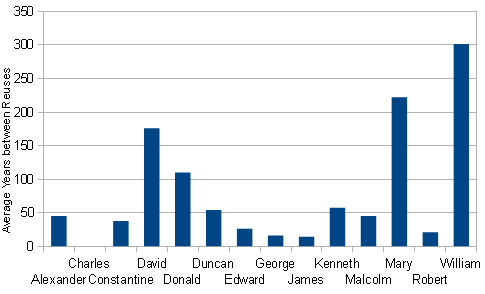You may remember when I investigated the gaps between reuse of names for English/British monarchs. At the time I left out Scottish monarchs because it complicated things, but I felt bad so I have done them now as well.
As with last time, to represent the end of one reign I’ve used the letter d (for “death”, though it wasn’t always), and s for the start of the next reign with that name. After the crowns of England and Scotland merged, the numbers skip ahead a bit because England had Edwards that Scotland didn’t, as well as an extra William.
Alexander
I d. 1124, II s. 1214 = 90 years.
II d. 1249, III s. 1249 = 0 years.
Charles
I d. 1649, II s. 1649 = 0 years.
Constantine
I d. 877, II s. 900 = 23 years.
II d. 943, III s. 995 = 52 years.
David
I d. 1153, II s. 1329 = 176 years.
Donald
I d. 862, II s. 889 = 27 years.
II d. 900, III s. 1093 = 193 years.
Duncan
I d. 1040, II s. 1094 = 54 years.
Edward
VII d. 1910, VIII s. 1936 = 26 years.
George
I d. 1727, II s. 1727 = 0 years.
II d. 1760, III s. 1760 = 0 years.
III d. 1820, IV s. 1820 = 0 years.
IV d. 1830, V s. 1910 = 80 years.
V d. 1936, VI s. 1936 (though not immediately succeeding) = 326 days = 0 years.
James
I d. 1437, II s. 1437 = 0 years.
II d. 1460, III s. 1460 = 0 years.
III d. 1488, IV s. 1488 = 0 years.
IV d. 1513, V s. 1513 = 0 years.
V d. 1542, VI s. 1567 = 25 years.
VI d. 1625, VII s. 1685 = 60 years.
Kenneth
I d. 858, II s. 971 = 113 years.
II d. 995, III s. 997 = 2 years.
Malcolm
I d. 954, II s. 1005 = 51 years.
II d. 1034, III s. 1058 = 24 years.
III d. 1093, IV s. 1153 = 60 years.
Mary
I d. 1467, II s. 1689 = 222 years.
Robert
I d. 1329, II s. 1371 = 42 years.
II d. 1390, III s. 1390 = 0 years.
William
I d. 1214, II s. 1689 = 475 years.
II d. 1702, IV s. 1830 = 128 years.
Interestingly, the answer is again William (the later William being in fact the same William who won for the English/British monarchs, though with 114 years removed because Scotland’s William I came after England’s William II). William is also the name that had the largest time pass between it’s first use and second use, with 672 years passing between the start of William I’s reign and the end of William IV’s.
Here is a graph of the averages for each name.

